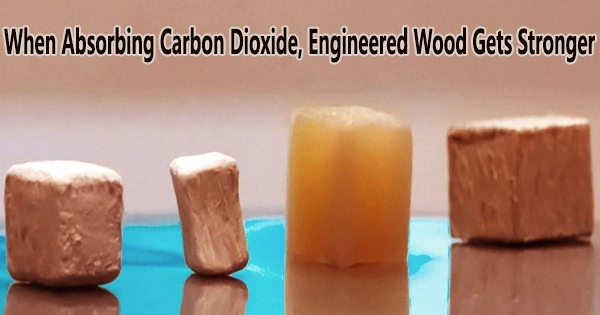Scientists at Rice University have developed a method to strengthen wood for use in buildings while also engineering it to trap carbon dioxide through a technique that may be scaled up and uses less energy.
Building construction and use are estimated to be responsible for 40% of carbon dioxide emissions, which makes structural elements like steel or cement expensive both financially and environmentally. Creating environmentally friendly substitutes for current materials could help slow global warming and cut carbon dioxide emissions.
According to a study published in Cell Reports Physical Science, materials scientist Muhammad Rahman and associates discovered a way to insert molecules of a carbon dioxide-trapping crystalline porous material into the wood in an effort to address both challenges simultaneously.
“Wood is a sustainable, renewable structural material that we already use extensively,” Rahman said. “Our engineered wood did exhibit greater strength than normal, untreated wood.”
Delignification, a method, is used to first remove the network of cellulose fibers that gives wood its strength in order to accomplish the task.
“Wood is made up of three essential components: cellulose, hemicellulose, and lignin,” Rahman said. “Lignin is what gives wood its color, so when you take lignin out, the wood becomes colorless. Removing the lignin is a fairly simple process that involves a two-step chemical treatment using environmentally benign substances. After removing the lignin, we use bleach or hydrogen peroxide to remove the hemicellulose.”
Wood is a sustainable, renewable structural material that we already use extensively. Our engineered wood did exhibit greater strength than normal, untreated wood.
Muhammad Rahman
Next, the delignified wood is soaked in a solution containing microparticles of a metal-organic framework, or MOF, known as Calgary framework 20 (CALF-20). MOFs are high-surface-area sorbent materials used for their ability to adsorb carbon dioxide molecules into their pores.
“The MOF particles easily fit into the cellulose channels and get attached to them through favorable surface interactions,” said Soumyabrata Roy, a Rice research scientist, and lead author on the study.
MOFs are among the nascent carbon capture technologies designed to combat anthropogenic climate change.
“Right now, there is no biodegradable, sustainable substrate for deploying carbon dioxide-sorbent materials,” Rahman said. “Our MOF-enhanced wood is an adaptable support platform for deploying sorbent in different carbon dioxide applications.”
“Many of the existing MOFs are not very stable in varying environmental conditions,” Roy said. “Some are very susceptible to moisture, and you don’t want that in a structural material.”
CALF-20, however, developed by University of Calgary Professor George Shimizu and collaborators, stands out in terms of both performance level and versatility under a variety of environmental conditions, Roy said.
“The manufacturing of structural materials such as metals or cement represents a significant source of industrial carbon emissions,” Rahman said. “Our process is simpler and ‘greener’ in terms of both substances used and processing byproducts.”
“The next step would be to determine sequestration processes as well as a detailed economic analysis to understand the scalability and commercial viability of this material,” he added.
Rahman is an assistant research professor in materials science and nanoengineering in Rice’s George R. Brown School of Engineering. Roy is a research scientist in materials science and nanoengineering at Rice.





